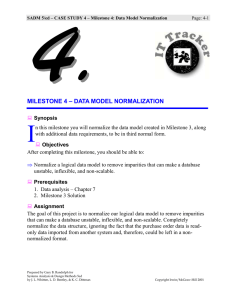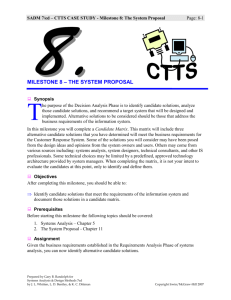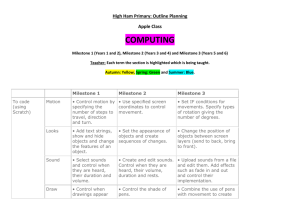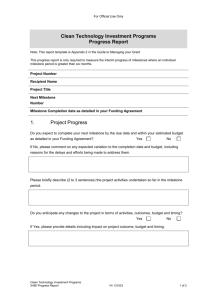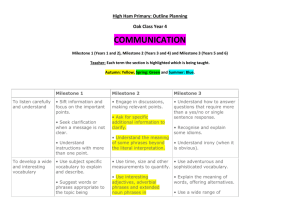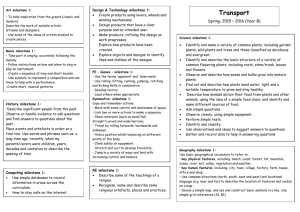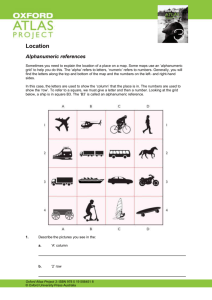Case Study CTTS - Milestone 05 Data Model
advertisement
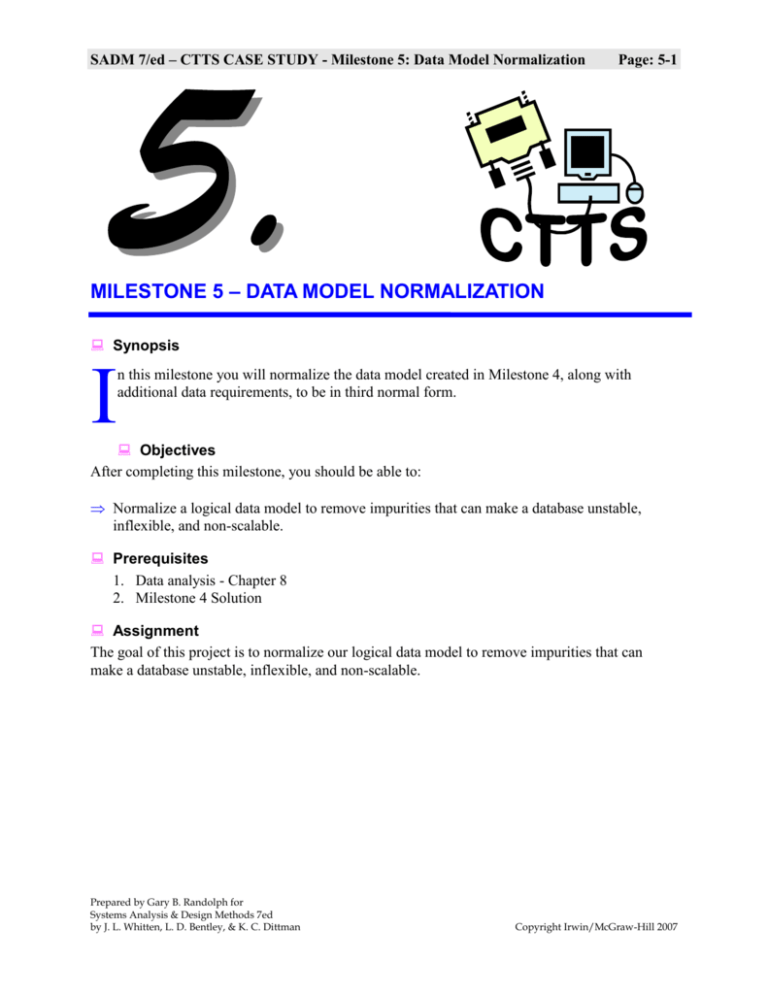
SADM 7/ed – CTTS CASE STUDY - Milestone 5: Data Model Normalization Page: 5-1 MILESTONE 5 – DATA MODEL NORMALIZATION Synopsis I n this milestone you will normalize the data model created in Milestone 4, along with additional data requirements, to be in third normal form. Objectives After completing this milestone, you should be able to: Normalize a logical data model to remove impurities that can make a database unstable, inflexible, and non-scalable. Prerequisites 1. Data analysis - Chapter 8 2. Milestone 4 Solution Assignment The goal of this project is to normalize our logical data model to remove impurities that can make a database unstable, inflexible, and non-scalable. Prepared by Gary B. Randolph for Systems Analysis & Design Methods 7ed by J. L. Whitten, L. D. Bentley, & K. C. Dittman Copyright Irwin/McGraw-Hill 2007 SADM 7/ed – CTTS CASE STUDY - Milestone 5: Data Model Normalization Page: 5-2 Activities 1. To construct an Entity Relationship Diagram to be in 3rd Normal form, follow the normalization procedure outlined in Chapter 8 of the SADM 7th ed. textbook. Use feedback from your the ERD solution of Milestone 4 as well as the data dictionary provided at the end of this milestone to prepare the new data model. 2. Specify all data types (your instructor will specify the target database or allowable set of data types). 3. Specify all primary and foreign keys. 4. Specify which attributes are required (not nullable). 5. Add and normalize additional entities and attributes as directed by your instructor. Make assumptions where necessary. Deliverable format and software to be used are according to your instructor’s specifications. Deliverables should be neatly packaged in a binder, separated with a tab divider labeled “Milestone 5”. References: Previous Milestone Solutions Provided by your instructor Data Attribute Dictionary Provided at the end of this milestone Refer to a Copy of Your Fully Attributed Data Model Created for Milestone 4. Deliverables: Logical Data Model in 3rd Normal Form: Milestone’s Point Value: Prepared by Gary B. Randolph for Systems Analysis & Design Methods 7ed by J. L. Whitten, L. D. Bentley, & K. C. Dittman Due: __/__/__ Time:_______ _______ Copyright Irwin/McGraw-Hill 2007 SADM 7/ed – CTTS CASE STUDY - Milestone 5: Data Model Normalization Page: 5-3 Data Attribute Dictionary Below is a Data Attribute Dictionary that contains all the attributes and definitions. Note: the attributes below are listed in alphabetical order, not by entity. Address Barcode City ClientID ClientName ComponentType ConfigurationID ContactFirstName ContactLastName DateInstalled DatePurch DateRemoved Description Email Equipment EquipName EquipNum EquipType FinishTime InfoName InfoValues InServiceDate ModelNum A 30-character alphanumeric field holding the client’s street or box address. A 20-character alphanumeric barcode ID that is either pre-printed on each component package or added via a label at Coastline Consulting. A 20-character alphanumeric field holding the name of the client’s city. A system-generated large integer numeric value unique to each client. A 50-character alphanumeric field holding the client’s company name. A 10-character alphanumeric classification of the type of component. A system-generated large integer numeric value unique to each software configuration record. A 20-character alphanumeric field consisting of the first name of the client contact person. A 30-character alphanumeric field consisting of last name of the client contact person. Date field consisting of the date a component was installed into a piece of equipment. A date field representing the date a component was purchased. Date field consisting of the date a component was removed from a piece of equipment. A 30-character description of the component. A 70-character alphanumeric field consisting of the client contact’s e-mail address. A 20-character alphanumeric description of the piece of equipment, if any, for a software configuration record. A 15-character alphanumeric field holding the identifying name for the piece of equipment A system-generated numeric value unique to each piece of equipment. A 10-character alphanumeric field identifying the equipment as PC, Printer, Scanner, etc. A time field holding the time a technician finished work on a request. A 20-character alphanumeric description of the information stored in a software configuration record. A 50-character alphanumeric information value stored in a software configuration record. A date field consisting of the date the piece of equipment was placed in service. A 10-character alphanumeric identifier of the model number of the component. Prepared by Gary B. Randolph for Systems Analysis & Design Methods 7ed by J. L. Whitten, L. D. Bentley, & K. C. Dittman Copyright Irwin/McGraw-Hill 2007 SADM 7/ed – CTTS CASE STUDY - Milestone 5: Data Model Normalization Quantity ReportDate ReportedBy ReqNum ResolutionDate StartTime State TechInitials Vendor WorkDate WorkDescription WorkNum Zip Page: 5-4 A numeric field specifying the quantity of items installed as an EquipmentComponent. This is always a whole number. An inspection of past forms shows no quantity exceeding 50. A date field holding the date a service request was reported. A 50-character alphanumeric field holding the first and last name of the person reporting a service request. A system-generated large integer numeric value unique to each service request. A date field holding the date a service request was resolved. A time field holding the time a technician began work on a request. A 2-character abbreviation for the client’s state. A 3-character alphanumeric field consisting of the initials of the technician performing work. A 30-character field holding the name of the vendor from whom a component was purchased. A date field consisting of the date a technician did work on a request. A large alphanumeric field describing the work done on a work record. A system-generated large integer numeric value unique to each work record. A 10-character alphanumeric postal code of a client. Prepared by Gary B. Randolph for Systems Analysis & Design Methods 7ed by J. L. Whitten, L. D. Bentley, & K. C. Dittman Copyright Irwin/McGraw-Hill 2007

